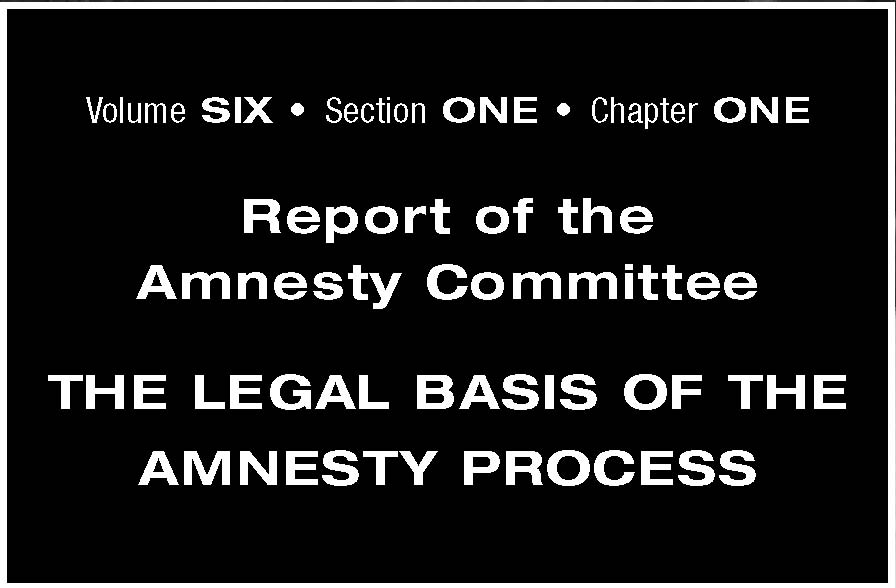 |
News | Sport | TV | Radio | Education | TV Licenses | Contact Us |
 |
News | Sport | TV | Radio | Education | TV Licenses | Contact Us |
TRC Final ReportPage Number (Original) 1 Paragraph Numbers 1 to 8 Volume 6 Section 1 Chapter 1 Subsection 1  Report of the Amnesty Committee■ INTRODUCTION1 In October 1998, the Amnesty Committee (the Committee) submitted an interim report to the Truth and Reconciliation Commission (the Commission). This formed part of the Final Report handed to President Mandela on 29 October 1998. The Final Report contains a broad overview of the functioning and activities of the Committee. In addition, Chapters Four (‘The Mandate’) and Five (‘Concepts and Principles’) of Volume One of the Final Report contribute towards a fuller understanding of the amnesty process. Chapter Four describes how the Commission was established and outlines the scope of its mandate, including that relating to the granting of amnesty. It also discusses how the Commission interpreted its mandate and how it went about identifying criteria derived from just war theory and other international human rights principles. The mandate and criteria guided the Commission in determining what constituted gross human rights violations and who or what entities could be held accountable for them, as envisaged in its founding Act, the Promotion of National Unity and Reconciliation Act No. 34 of 1995 (the Act). 2 In Chapter Five of Volume One of its Final Report, the Commission discusses questions of amnesty, truth and justice, the relationship between these three complex concepts and their role in and contribution to furthering the C o m mission ’s over- arching objective of promoting reconciliation and a sense of national unity. 3 Although the activities of the Commission were suspended on 29 October 1998, the Amnesty Committee was authorised to continue until it had completed its outstanding work. This it did at the end of May 2001. Moreover, when the lifespan of the Committee was extended in October 1998, certain outstanding duties of both the Human Rights Violations Committee (HRVC) and the Reparation and Rehabilitation Committee (RRC) were statutorily placed under the auspices of the Committee in accordance with an appropriate amendment of the Act. At this stage, two Commissioners, representing the HRVC and RRC respectively, joined the extended Committee to attend to these duties. 4 The purpose of the present section is to account for the activities of the Amnesty Committee from October 1998 until its dissolution on 31 May 2001.1 5 It is apposite at the outset of this section to repeat an observation made in the report of the Committee in October 1998, namely that, in the view of the Committee, the terms of its statutory mandate and the judicial nature of its activities preclude it from commenting upon or analysing its decisions or its approach to specific cases in this Report. In the Committee’s view, this would amount to an actionable gross irregularity. 6 In compliance with the judicial nature of its mandate, the Committee has given fully reasoned decisions in all hearable amnesty applications as well as motivated decisions in all substantive chamber matters. These decisions constitute the sole repository of the Committee’s views on all the substantive issues that were relevant to its activities in relation to the matter of amnesty in general and to the specific amnesty applications it considered. The decisions have been reproduced in full and, due to space constraints, accompany this report in electronic form (compact disc). The decisions are fully indexed to enhance their accessibility to interested parties. All decisions in hearable matters have, more o v e r, been made available on the website of the Department of Justice and Constitutional Development (http://www.doj.gov.za/trc/index.html) in order to promote public access.2 7 Finally, we would like to dedicate these chapters on the work of the Amnesty Committee to those members who passed away during the lifespan of the Committee – in recognition of their contribution, dedication and commitment to a process that is, to date, unrivalled not only in South Africa but in the entire world. They are: a The Honourable Mr Justice Hassen Mall: Chairperson; b Advocate Robin Brink: Evidence Leader, and c Mr Dugard Macaqueza: Investigator and Evidence Analyst. 8. The amnesty section of the Report is also dedicated to all Committee members and staff, without whose commitment, dedication and contribution it would have been impossible to give effect to the provisions of the Act. Dealing with the atrocities of the past on a daily basis over a period of almost five and a half years was never easy. Equally difficult were the many days spent on the road , visiting venues all over the country and listening to and adjudicating upon reprehensible acts of severe gross human rights violations. 1 In terms of Proclamation R31 dated 23 May 2001. 2 See Section Fi v e, Chapter Seven , ‘Recommendations’ in this volume for further action contemplated in respect of the Commission’s archives. |